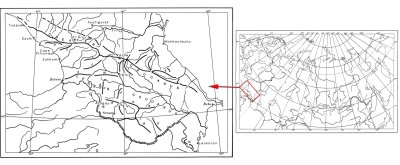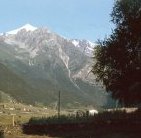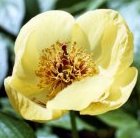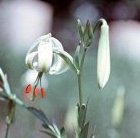 |
QUICK SEARCH
MO PROJECTS:
Africa
Asia/Pacific
Mesoamerica
North America
South America
General Taxonomy
Photo Essays
Training in Latin
America
MO RESEARCH:
Wm. L. Brown Center
Bryology
GIS
Graduate Studies
Research Experiences
for Undergraduates
Imaging Lab
Library
MBG Press
Publications
Climate Change
Catalog Fossil Plants
MO DATABASES:
W³MOST
Image Index
Rare Books
Angiosperm
Phylogeny
Res Botanica
All Databases
INFORMATION:
What's New?
People at MO
Visitor's Guide
Herbarium
Jobs & Fellowships
Symposium
Research Links
Site Map
Search
ORNAMENTAL PLANTS IN THEIR NATURAL HABITATSThe Caucasus
Rich floras are typical of all of the above regions, but the Caucasus clearly displays the most diversity. The Caucasian mountains lie between the Black and Caspian seas to the north of Turkey and Iran. There are two main ranges, the Greater Caucasus and the Lesser Caucasus, which run parallel from the northwest to the southeast for over 1,500 km/900 miles. Hollis and Brummit (1992) divide the Caucasus into two
The Caucasus is mentioned in the Bible, when the waters of the Flood subsided the Ark landed on Mount Ararat which served as a resting place for Noah. The ancient state of Chaldea (called "Urartu" by the Assyrians), was located in southwestern Asia, on the Euphrates River and the Persian Gulf; and in the 9th century BC south Armenia was part of this country. It was famous for its advanced agriculture, particularly known for its diversity of wild wheats. To this day the same area is famous for the excellent bread called Armenian bread, which stays fresh for a long period, and no place on earth that can match the Transcaucasus in the number of wild wheat or Triticum species. Here, in Georgia and Armenia there are 8 endemic species of Triticum. These territories were the first ones where the wheats were cultivated (Zhukovsky, 1964). Vegetation of the Caucasus is remarkably luxuriant and rich. A large area of the mountains is covered by forests, and near the snowline at ca. 2,700 m (9,000 ft), a magnificent alpine vegetation thrives. Snow-capped peaks create spectacular landscapes, the principal peaks being El’brus (5,633 m/18,468 ft), the highest mountain in Europe, and Kazbek (5,047 m/16,558 ft). The southwestern Caucasus is characterized by a warm and humid climate, but to the north and east this is more continental, and in some places even arid conditions exist. Various authors give different numbers for ornamental species in the Caucasus. Grossheim (1952) estimated that there were about 5,000 species in the Caucasus, of which 600 are ornamental. Other Caucasian botanists,
A good rule of thumb is to seek new ornamentals in genera with species already in garden cultivation, but the Caucasian flora amazingly contains ornamental species that belong to genera totaly unknown in cultivation. Recent discoveries in the daisy family include a very good groundcover plant Cladochaeta endemic Caucasian genus with two species and a beautiful pink-flowered perennial Kemulariella with six species on the Caucasus. New species of "old" genera are essential for hybridization and can play important roles. For example, "new blood" is highly desirable for future paeony breeding because most of the possibilities within Paeonia lactiflora seems to be exhausted. Of special significance are the yellow-flowered paeonies Paeonia mlokosewitschii, P. steveniana, P. tomentosa and P. wittmanniana. The crimson-flowered P. caucasica may also be important for breeding purposes. Caucasian lilies can also give many excellent hybrids. Of the six Caucasian species, the most showy are a white-flowered Lilium ledebourii and the lemon-flowered L. kesselringianum. The Caucasian Iris, Gladiolus and Helleborus species may likely prove valuble for producing hybrids. Species of the last genus or Christmas rose have given rise to extremely diverse, natural hybrids whenever several species grow together, as in Abkhazia. There, both white and richly dark red-flowered forms have been collected. Large-flowered or curiously coloured forms are seen restricted to certain areas. A white-flowered form of Stachys macrantha, for example, grows near Bakuriani, and comes from seed in cultivation. An impressively blue large-flowered Delphinium speciosum (to 3 cm/ 1.2") has been collected throughout the entire range, and yet another elegant small-flowered form of the same species occurs in the northern Caucasus and Ossetia. Certain species exhibit unusual features in different geographic areas, for example, sometimes Potentilla divina can produce rather large pink flowers and white-hairy, ternate leaves, Hylotelephium caucasicum develops creeping stems and deep dark red inflorescences, and Caltha polypetala forms are seen with double flowers with 7 to 10 sepals. Extensive altitudinal distribution is characteristic of Caucasian species having widespead ranges. However, some are endemic species and occur in only one peculiar mountain zone. These species will require special environmental conditions in cultivation. Ornamental Caucasian plants that demonstrate very diverse habitat preferences are particularly valuable because they adapt well to diverse enviroments and can be grown in different geographical regions. |
|||||
| ORNAMENTAL PLANTS FROM RUSSIA |
© 1995-2025 Missouri Botanical Garden, All Rights Reserved
4344 Shaw Blvd.
St. Louis, MO 63110
(314) 577-5100
Technical Support




